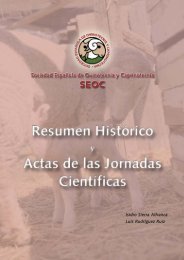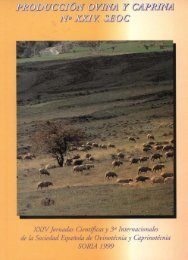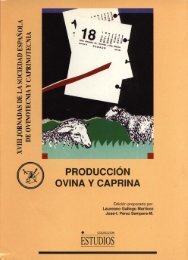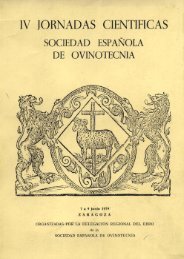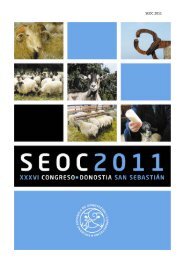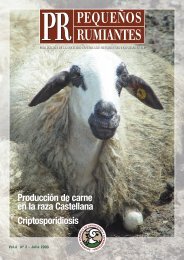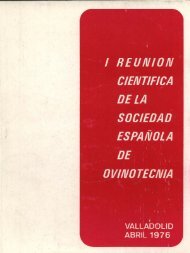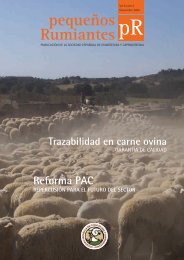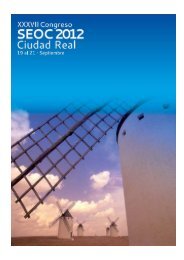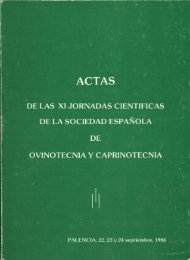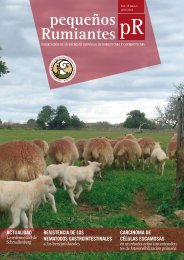- Page 1:
PRODUCCIÓN OVINA Y CAPRINAN.º XXI
- Page 4 and 5:
COORDINADORESIgnacia Beltrán de He
- Page 6 and 7:
4recursos renovables, pastos, en si
- Page 8 and 9:
6respuestas a los problemas de la p
- Page 10 and 11:
8EVOLUCIÓN ANUAL DE LA DEGRADABILI
- Page 12 and 13:
10GENÉTICASITUACIÓN ACTUAL DEL ES
- Page 14 and 15:
12VALORACIÓN DE UN PLAN DE CONTROL
- Page 16 and 17:
14PRODUCCIÓNANÁLISIS DEL EFECTO D
- Page 18 and 19:
16RESULTADOS EN INSEMINACIÓN ARTIF
- Page 21 and 22:
Producción Ovina y Caprina • 199
- Page 23 and 24:
ACTIVITÉS DE PÂTURAGE, PAYSAGES E
- Page 25 and 26:
ACTIVITÉS DE PÂTURAGE, PAYSAGES E
- Page 27 and 28:
ACTIVITÉS DE PÂTURAGE, PAYSAGES E
- Page 29 and 30:
ACTIVITÉS DE PÂTURAGE, PAYSAGES E
- Page 31 and 32:
ACTIVITÉS DE PÂTURAGE, PAYSAGES E
- Page 33 and 34:
Producción Ovina y Caprina • 199
- Page 35 and 36:
CONSERVACIÓN DEL SEMEN DE MACHO CA
- Page 37 and 38:
CONSERVACIÓN DEL SEMEN DE MACHO CA
- Page 39 and 40:
Producción Ovina y Caprina • 199
- Page 41 and 42:
SITUACIÓN DE LA MEJORA GENÉTICA D
- Page 43 and 44:
SITUACIÓN DE LA MEJORA GENÉTICA D
- Page 45 and 46:
SITUACIÓN DE LA MEJORA GENÉTICA D
- Page 47 and 48:
SITUACIÓN DE LA MEJORA GENÉTICA D
- Page 49:
MESA REDONDA
- Page 52 and 53:
50 BLASCO, J.M.nuidad temporal gara
- Page 55 and 56:
Producción Ovina y Caprina • 199
- Page 57 and 58:
PROBLEMÁTICA DE LA BRUCELOSIS Y SU
- Page 59 and 60:
Producción Ovina y Caprina • 199
- Page 61 and 62:
PLANIFICACIÓN DE UNA CAMPAÑA DE S
- Page 63 and 64:
Producción Ovina y Caprina • 199
- Page 65 and 66:
LA BRUCELOSIS EN LA COMUNIDAD AUTÓ
- Page 67 and 68:
Producción Ovina y Caprina • 199
- Page 69:
ALIMENTACION
- Page 72 and 73:
70MADRID, J. • HERNÁNDEZ, F. •
- Page 74 and 75:
72MADRID, J. • HERNÁNDEZ, F. •
- Page 76 and 77:
74MADRID, J. • MEGÍAS, M.D. •
- Page 78 and 79:
76MADRID, J. • MEGÍAS, M.D. •
- Page 80 and 81:
78ALVIR, M. R. • PANIAGUA, E & GO
- Page 82 and 83:
80ALVIR, M. R. • PANIAGUA, E & GO
- Page 84 and 85:
82ASENJO, B. • CIRIA, J. • SANZ
- Page 86 and 87:
84ASENJO, B. • CIRIA, J. • SANZ
- Page 88 and 89:
86MARTÍNEZ TERUEL, A. • MEGÍAS
- Page 90 and 91:
88MARTÍNEZ TERUEL, A. • MEGÍAS
- Page 92 and 93:
90LOPEZ GALLEGO, F. • ESTÉVEZ HE
- Page 94 and 95:
92LOPEZ GALLEGO, F. • ESTÉVEZ HE
- Page 96 and 97:
94GRACIA, J.L. • LANAU, A. • FL
- Page 98 and 99:
96HORCAS, E. • CUARTIELLES, M.I.
- Page 101 and 102:
Producción Ovina y Caprina • 199
- Page 103 and 104:
LA ADICIÓN DE DL-METIONINA Y β-GL
- Page 105:
LA ADICIÓN DE DL-METIONINA Y β-GL
- Page 109:
Calidad•CARNE
- Page 112 and 113:
110HORCAS, E • CUARTIELLES, M.I.
- Page 115 and 116:
Producción Ovina y Caprina • 199
- Page 117 and 118:
EFECTO DEL SISTEMA DE DESTETE EN LA
- Page 119 and 120:
Producción Ovina y Caprina • 199
- Page 121 and 122:
EFECTO DEL SISTEMA DE DESTETE EN LA
- Page 123:
EFECTO DEL SISTEMA DE DESTETE EN LA
- Page 126 and 127:
124HUIDOBRO, F. et al.aumentar la c
- Page 128 and 129:
126HUIDOBRO, F. et al.Los rendimien
- Page 131 and 132:
Producción Ovina y Caprina • 199
- Page 133 and 134:
ENGORDE DE CORDEROS TALAVERANOS EN
- Page 135 and 136:
Producción Ovina y Caprina • 199
- Page 137 and 138:
CARACTERIZACIÓN DE LA CALIDAD DE L
- Page 139:
CARACTERIZACIÓN DE LA CALIDAD DE L
- Page 142 and 143:
140CONESA GIMENO, A. • PÉREZ LAV
- Page 144 and 145:
142ARGÜELLO, A. • GINÉS, R. •
- Page 146 and 147:
144ARGÜELLO, A. • GINÉS, R. •
- Page 148 and 149:
146DELFA, R. • TEIXEIRA, A. • G
- Page 150 and 151:
148DELFA, R. • TEIXEIRA, A. • G
- Page 153 and 154:
Producción Ovina y Caprina • 199
- Page 155 and 156:
CONTENIDO Y COMPOSICIÓN DE LA GRAS
- Page 157 and 158:
Producción Ovina y Caprina • 199
- Page 159 and 160:
CALOSTRO DE LA AGRUPACIÓN CAPRINA
- Page 161 and 162:
Producción Ovina y Caprina • 199
- Page 163 and 164:
ESTUDIO DE LOS MÉTODOS DE DETECCI
- Page 165 and 166:
Producción Ovina y Caprina • 199
- Page 167 and 168:
ESTUDIO DEL SISTEMA LACTOPEROXIDASA
- Page 169 and 170:
Producción Ovina y Caprina • 199
- Page 171 and 172:
INFLUENCIA DE LA RAZA EN PRODUCCIÓ
- Page 173 and 174:
Producción Ovina y Caprina • 199
- Page 175 and 176:
INFLUENCIA DE LA RAZA EN EL RENDIMI
- Page 177 and 178:
Producción Ovina y Caprina • 199
- Page 179 and 180:
FACTORES QUE INFLUYEN EN EL TIEMPO
- Page 181 and 182:
Producción Ovina y Caprina • 199
- Page 183 and 184:
ESTUDIO PRELIMINAR PARA LA ESTIMACI
- Page 185 and 186:
Producción Ovina y Caprina • 199
- Page 187 and 188:
TECNOLOGÍA DE LA ELABORACIÓN Y AC
- Page 189 and 190:
Producción Ovina y Caprina • 199
- Page 191 and 192:
ASPECTOS MICROBIOLÓGICOS EN LA FAB
- Page 193 and 194:
Producción Ovina y Caprina • 199
- Page 195 and 196:
CARACTERIZACIÓN Y CONTROL DE CALID
- Page 197:
GENÉTICA
- Page 200 and 201:
198VALDEMOROS, F. et al.Tabla 1. Di
- Page 202 and 203:
200VALDEMOROS, F. et al.* Guardar l
- Page 204 and 205:
202JURADO, J.J. et al.de aplicar di
- Page 206 and 207:
204JURADO, J.J. et al.Catálogo de
- Page 208 and 209:
206SERRANO MOYANO, B. et al.RESULTA
- Page 210 and 211:
208SERRANO MOYANO, B. et al.doble a
- Page 212 and 213:
210ARRUGA, M.V. • MONTEAGUDO, L.V
- Page 214 and 215:
212ARRUGA, M.V. • MONTEAGUDO, L.V
- Page 216 and 217:
214GUTIÉRREZ, C. et al.realizarse
- Page 218 and 219:
216GÓMEZ, M. • GOROSTIZA, P. & U
- Page 220 and 221:
218GÓMEZ, M. • GOROSTIZA, P. & U
- Page 222 and 223:
220RODRÍGUEZ, M. • FERNÁNDEZ, N
- Page 224 and 225:
222RODRÍGUEZ, M. • FERNÁNDEZ, N
- Page 227 and 228:
Producción Ovina y Caprina • 199
- Page 229 and 230:
DISTRIBUCIÓN Y EVOLUCIÓN DEL GANA
- Page 231 and 232:
Producción Ovina y Caprina • 199
- Page 233 and 234:
SITUACIÓN ESTRUCTURAL DE LA PRODUC
- Page 235 and 236:
Producción Ovina y Caprina • 199
- Page 237 and 238:
ASPECTOS SOCIOECONÓMICOS DE LAS GA
- Page 239 and 240:
Producción Ovina y Caprina • 199
- Page 241 and 242:
ESTUDIO SOCIO-ECONÓMICO DEL SECTOR
- Page 243 and 244:
ESTUDIO SOCIO-ECONÓMICO DEL SECTOR
- Page 245 and 246:
Producción Ovina y Caprina • 199
- Page 247 and 248:
ARTZAI ESKOLA: UN PROYECTO PILOTO D
- Page 249 and 250:
Producción Ovina y Caprina • 199
- Page 251 and 252:
RESULTADOS TÉCNICO-ECONÓMICOS DE
- Page 253 and 254:
Producción Ovina y Caprina • 199
- Page 255 and 256:
EVOLUCIÓN DE LOS RESULTADOS TÉCNI
- Page 257 and 258:
Producción Ovina y Caprina • 199
- Page 259 and 260:
Producción Ovina y Caprina • 199
- Page 261 and 262:
Producción Ovina y Caprina • 199
- Page 263 and 264:
OVINO DE CARNE: RESULTADOS ECONÓMI
- Page 265:
OVINO DE CARNE: RESULTADOS ECONÓMI
- Page 268 and 269:
266SANTAMARÍA, C. et al.sequía en
- Page 270 and 271:
268Tabla 2. Comparación de resulta
- Page 273 and 274:
Producción Ovina y Caprina • 199
- Page 275:
EFICIENCIA TÉCNICO-ECONÓMICA EN E
- Page 278 and 279:
276TABERNERO, J.I.corrector mineral
- Page 280 and 281:
278TABERNERO, J.I.
- Page 283:
PATOLOGÍA:GENERAL
- Page 286 and 287:
284CORPA, J.M. • GARCÍA MARÍN,
- Page 288 and 289:
286CORPA, J.M. • GARCÍA MARÍN,
- Page 290 and 291:
288GARRIDO, J.M. et al.incubación
- Page 292 and 293:
290GARRIDO, J.M. et al.Tabla 2. Pre
- Page 294 and 295:
292GARRIDO, J.M. • CORTABARRÍA,
- Page 296 and 297:
294GARRIDO, J.M. • CORTABARRÍA,
- Page 298 and 299:
296GÓMEZ, N. • GUTIÉRREZ, M.M.
- Page 300 and 301:
298GÓMEZ, N. • GUTIÉRREZ, M.M.
- Page 302 and 303:
300EXTRAMIANA, A.B. • CORTABARRÍ
- Page 304 and 305:
302EXTRAMIANA, A.B. • CORTABARRÍ
- Page 306 and 307:
304GARCÍA, M. et al.La primera es
- Page 308 and 309:
306GARCÍA, M. et al.como de alcanz
- Page 310 and 311:
308GUIJOSA, F. • CANO, T. & MART
- Page 312 and 313:
310GUIJOSA, F. • CANO, T. & MART
- Page 315 and 316:
Producción Ovina y Caprina • 199
- Page 317:
VALORACION DE UN PLAN DE CONTROL DE
- Page 320 and 321:
318GIL, M.C. et al.MATERIAL Y METOD
- Page 322 and 323:
320GIL, M.C. et al.morbilidad bajos
- Page 324 and 325:
322GARCÍA PÉREZ, A.L. et al.- An
- Page 326 and 327:
324GARCÍA PÉREZ, A.L. et al.líqu
- Page 328 and 329:
326RODRÍGUEZ, A. & PÉREZ, I.3.-Ú
- Page 330 and 331:
328RODRÍGUEZ, A. & PÉREZ, I.Figur
- Page 332 and 333:
330RODRÍGUEZ, A. & PÉREZ, I.REFER
- Page 334 and 335:
332RODRÍGUEZ-PONCE, E. et al.Toxop
- Page 336 and 337: 334RODRÍGUEZ-PONCE, E. et al.isoti
- Page 339 and 340: Producción Ovina y Caprina • 199
- Page 341 and 342: PREVALENCIA Y PROBLEMÁTICA MAS FRE
- Page 343 and 344: Producción Ovina y Caprina • 199
- Page 345: INTOXICACION POR COBRE ASOCIADA AL
- Page 348 and 349: 346NÚÑEZ, C. • GARCÍA MARÍN,
- Page 350 and 351: 348NÚÑEZ, C. • GARCÍA MARÍN,
- Page 352 and 353: 350GUTIÉRREZ, C. et al.males de al
- Page 354 and 355: 352PÉREZ, V. • CORPA, J.M. & GAR
- Page 356 and 357: PÉREZ, V. • CORPA, J.M. & GARCÍ
- Page 358 and 359: 356GARCÍA MARÍN, J. et al.monocyt
- Page 360 and 361: SERVICIO DE DIAGNÓSTICO ANATOMOPAT
- Page 362 and 363: 360GÓMEZ, N. • GONZÁLEZ, J. •
- Page 364 and 365: 362GÓMEZ, N. • GONZÁLEZ, J. •
- Page 367 and 368: Producción Ovina y Caprina • 199
- Page 369 and 370: RELACIÓN ENTRE RCS DE TANQUE Y POR
- Page 371 and 372: Producción Ovina y Caprina • 199
- Page 373 and 374: UTILIZACIÓN DEL RCS DEL CONTROL LE
- Page 375: UTILIZACIÓN DEL RCS DEL CONTROL LE
- Page 378 and 379: 376MARTÍNEZ, B. & PERIS, C.célula
- Page 380 and 381: 378MARTÍNEZ, B. & PERIS, C.En la T
- Page 383 and 384: Producción Ovina y Caprina • 199
- Page 385: VARIACION DEL ESPESOR DEL PEZON EN
- Page 389 and 390: Producción Ovina y Caprina • 199
- Page 391 and 392: APORTES A LA PREVALENCIA Y ETIOLOG
- Page 393 and 394: Producción Ovina y Caprina • 199
- Page 395 and 396: Producción Ovina y Caprina • 199
- Page 397 and 398: VALORACIÓN DE LA EFICACIA DEL POTE
- Page 399: VALORACIÓN DE LA EFICACIA DEL POTE
- Page 402 and 403: 400GARCÍA, M.E. et al.Sueros: Util
- Page 404 and 405: 402GARCÍA, M.E. et al.REFERENCIAS
- Page 406 and 407: 404PÉREZ, V. • CORPA, J.M. • A
- Page 408 and 409: 406PÉREZ, V. • CORPA, J.M. • A
- Page 410 and 411: 408LAS HERAS, A. et al.progresiva a
- Page 412 and 413: 410LAS HERAS, A. et al.aspects clin
- Page 414 and 415: 412LAS HERAS, A. et al.MATERIAL Y M
- Page 416 and 417: 414LAS HERAS, A. et al.dies of clin
- Page 418 and 419: 416MARTÍ, A. • MOLINA, P. • D
- Page 420 and 421: 418MARTÍ, A. • MOLINA, P. • D
- Page 422 and 423: 420SERRANO MOYANO, B. et al.MATERIA
- Page 424 and 425: 422SERRANO MOYANO, B. et al.Figura
- Page 427 and 428: Producción Ovina y Caprina • 199
- Page 429 and 430: GLUTATION PEROXIDASA (GSHPx) Y MAMI
- Page 431: PRODUCCIÓN
- Page 434 and 435: 432RUIZ, R. & OREGUI, L.M.se ha cal
- Page 436 and 437:
434RUIZ, R. & OREGUI, L.M.% Ov. Ord
- Page 438 and 439:
436CABALLERO DE LA CALLE, J.R.quinc
- Page 440 and 441:
438CABALLERO DE LA CALLE, J.R.Manch
- Page 442 and 443:
440CABALLERO DE LA CALLE, J.R.Tabla
- Page 444 and 445:
442ALBIZU, I. et al.en un gradiente
- Page 446 and 447:
444ALBIZU, I. et al.Tabla 2. Valore
- Page 449 and 450:
Producción Ovina y Caprina • 199
- Page 451 and 452:
UTILIZACION DE LOS PASTIZALES DE AL
- Page 453 and 454:
Producción Ovina y Caprina • 199
- Page 455 and 456:
COMPORTAMIENTO DE LOS REBAÑOS OVIN
- Page 457:
COMPORTAMIENTO DE LOS REBAÑOS OVIN
- Page 460 and 461:
458SERRANO MOYANO, B. et al.1. Plan
- Page 462 and 463:
460SERRANO MOYANO, B. et al.cereale
- Page 464 and 465:
462OSORIO, J.C. • MARÍA, G. •
- Page 466 and 467:
464OSORIO, J.C. • MARÍA, G. •
- Page 468 and 469:
466OSORIO, J.C. • SIERRA, I. •
- Page 470 and 471:
468OSORIO, J.C. • SIERRA, I. •
- Page 472 and 473:
470COMBELLAS, J. DE • RONDÓN, Z.
- Page 475 and 476:
Producción Ovina y Caprina • 199
- Page 477:
EFECTO DE RAZA DEL PADRE Y DE LA MA
- Page 480 and 481:
478JIMÉNEZ, M.A. • IZQUIERDO, M.
- Page 482 and 483:
480JIMÉNEZ, M.A. • IZQUIERDO, M.
- Page 485 and 486:
Producción Ovina y Caprina • 199
- Page 487 and 488:
485INTENSIFICACION REPRODUCTIVO-PRO
- Page 489:
INTENSIFICACION REPRODUCTIVO-PRODUC
- Page 492 and 493:
490HORCAS, E. • CUARTIELLES, M.I.
- Page 494 and 495:
492LLORENTE GIL, J.A. • ASENJO MA
- Page 496 and 497:
494LLORENTE GIL, J.A. • ASENJO MA
- Page 499 and 500:
Producción Ovina y Caprina • 199
- Page 501 and 502:
CRIORRESISTENCIA DEL SEMEN DE OVINO
- Page 503 and 504:
Producción Ovina y Caprina • 199
- Page 505 and 506:
REVERSIÓN DE LOS DAÑOS PRODUCIDOS
- Page 507:
REVERSIÓN DE LOS DAÑOS PRODUCIDOS
- Page 510 and 511:
508BARRIOS, B. et al.con el desarro
- Page 512 and 513:
510BARRIOS, B. et al.Tabla 2.- Porc
- Page 515 and 516:
Producción Ovina y Caprina • 199
- Page 517:
INFLUENCIA DE LA ADICIÓN DE ALGUNO
- Page 520 and 521:
518GRACIA, A. et al.congelaba semen
- Page 522 and 523:
520GRACIA, A. et al.yolk in the dil
- Page 524 and 525:
522AGUADO, M.J. et al.de yema de hu
- Page 526 and 527:
524AGUADO, M.J. et al.JONES, R.C.;
- Page 528 and 529:
526CABRERA, F. et al.Tabla 1: Infor
- Page 530 and 531:
528CABRERA, F. et al.estacionales,
- Page 532 and 533:
530BELTRÁN DE HEREDIA, I. • ARRE
- Page 534 and 535:
532BELTRÁN DE HEREDIA, I. • ARRE
- Page 537 and 538:
Producción Ovina y Caprina • 199
- Page 539 and 540:
INDUCCION DE LA REACCION ACROSOMICA
- Page 541:
INDUCCION DE LA REACCION ACROSOMICA
- Page 544 and 545:
542FANTOVA, E. et al.(5) y Zaragoza
- Page 546 and 547:
544FANTOVA, E.c) Tipo de diluyente
- Page 549 and 550:
Producción Ovina y Caprina • 199
- Page 551:
RESULTADOS EN INSEMINACIÓN ARTIFIC
- Page 554 and 555:
552ÁLVAREZ, M. et al.MATERIAL Y M
- Page 557 and 558:
Producción Ovina y Caprina • 199
- Page 559:
ECOGRAFIA TRANSRECTAL EN EL DIAGNOS
- Page 562 and 563:
560LOZANO, J.M. • ABECIA, A. & FO
- Page 565 and 566:
Producción Ovina y Caprina • 199
- Page 567 and 568:
UTILIZACIÓN DE IMPLANTES SUBCUTÁN
- Page 569 and 570:
Producción Ovina y Caprina • 199
- Page 571 and 572:
INTERACCIÓN SELENIO-REPRODUCCIÓN
- Page 573 and 574:
Producción Ovina y Caprina • 199
- Page 575 and 576:
INFLUENCIA DE LA PRESENCIA DE QUIST
- Page 577 and 578:
Producción Ovina y Caprina • 199
- Page 579:
FACTORES CONDICIONANTES DE LA RESPU
- Page 582 and 583:
580SANTIAGO MORENO, J. et al.males
- Page 584 and 585:
582SANTIAGO MORENO, J. et al.GINDRE
- Page 586 and 587:
584LANDETE-CASTILLEJOS, T. • GARD
- Page 588:
586LANDETE-CASTILLEJOS, T. • GARD




